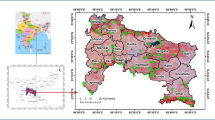Abstract
Detailed studies on population structure and regeneration ecology of Ilex khasiana were carried out at five representative natural populations i.e. Mylliem (Population - I), Upper Shillong (Population - II), Shillong Peak (Population - III), Laitkor (Population - IV) and Nongpiyur (Population - V) to probe into the responsible affecting factors for its population structure and regeneration ability in these populations. Experimental observation under three controlled light conditions (full sunlight (100%), intermediate sunlight (50%) and low sunlight (30%)) showed that the growth status and survival rates of seedlings under intermediate and low light were better than those under the high light condition. The density-diameter distribution in population of adult trees (≥5cm dbh) exhibited a typical character of a regenerating population. A higher seedling mortality rate in natural populations of I. khasiana was most probably due to increase in light intensity following vegetation destruction and other anthropogenic disturbances that cause opening of forest canopy. The findings of the present study would be of immense value in formulating appropriate conservation measures for the species.
Similar content being viewed by others
References
Barik SK, Pandey HN, Tripathi RS, Rao P. 1992. Microenvironmental variability and species diversity in treefall gaps in subtropical broad leaved forest. Vegetatio, 103: 31–40.
Boring LR, Monk CD, Swank WT. 1981. Early regeneration of a clearcut South Appalachian forest. Ecology, 62: 1244–1253.
Castillo PN, Hall RB. 2000. Sprouting capability of 17 tropical tree species after overstory removal in Quintana Roo, Mexico. Forest Ecology and Management, 126: 399–403.
Champion HG, Seth, SK. 1968. A Revised Survey of the Forest Types of India. New Delhi: Government of India.
Crawford RMM. 1989. Studies in Plant Survival: Ecological Case Histories of Plant Adaptation to Adversity. Oxford, Boston: Blackwell Scientific Publications, pp. 296.
Gazoul J, Listen KA, Boyle TJB. 1998. Disturbance induced density- dependent seed set in Shorea siamensis (Dipterocarpaceae) a tropical forest tree. Journal of Ecology, 86: 462–473.
Haridasan K, Rao RR. 1982. Notes on distribution of certain rare, endangered or endemic plants of Meghalaya with a brief remark on the flora. Journal of Bombay Natural History Society, 79: 93–99.
Haridasan K, Rao RR. 1985. Forest Flora of Meghalaya Vol. 1. Bishen Singh Mehandrapal Singh, 23-A, Connaught Place, Dehradun, India, pp. 450.
IUCN 2007. IUCN Red List of Threatened Species. Available at www.iucnredlist.org.
Kadaval K, Parthasarathy N. 2001. Population analysis of Alphonsea sclerocarpa Thw. (Annonaceae) in the Kalyaran Hills of Eastern Ghats India. International Journal of Ecology and Environmental Science, 27: 51–54.
Krenova Z, Leps J. 1996. Regeneration of a Gentiana pneumonanthe population in an oligotrophic wet meadow. Journal of vegetation Science, 7: 107–112.
Luoga EJ, Witkowski ETF, Balkwill K. 2004. Regeneration by coppicing (resprouting) of miombo (African savanna) trees in relation to land use. Forest Ecology and Management, 189: 23–35.
Rao P, Barik SK, Pandey HN, Tripathi RS. 1990. Community composition and tree population structure in a subtropical broad-leaved forest along a disturbance gradient. Vegetatio, 88: 151–162.
Rao RR, Haridasan K. 1983. Threatened plants of Meghalaya - a plea for conservation. In: Jain, S.K. and Rao, R.R. (Eds.), An Assessment of Threatened Plants of India. Howrah: Botanical Survey of India,, pp. 94–103.
Rundel PW. 1991. Shrub life-forms. In: Mooney, H.A., Winner, W.E. and Pell, E.J. (Eds.), Response of Plants to Multiple Stresses (Physiological Ecology Series). New York: Academic Press, pp. 345–370.
Sukumar R, Dattaraja HS, Suresh HS, Radhakrishnan J, Vasudeva R, Nirmala S, Joshi NV. 1992. Long-term monitoring of vegetation in a tropical deciduous forest in Mudumalai, Southern India. Current Science, 62 (9): 608–616.
Vega IL, Ayala OA, Contreras-Medina R. 2004. Patterns of diversity, endemism and conservation: an example with Mexican species of Ternstroemiaceae Mirb. ex DC. (Tricolpates: Ericales). Biodiversity and Conservation, 13: 2723–2739.
Walter KS, Gillett HJ. 1998. 1997 IUCN Red List of Threatened Plants. Compiled by the World Conservation Monitoring Centre. IUCN - The World Conservation Union, IUCN Publications Services Unit, 219c, Huntingdon Road, Cambridge CB3 ODL, UK, pp. 862.
Williams N. 1998. Study finds 10% of tree species under threat. Science, 281 (5382): 1426.
Author information
Authors and Affiliations
Corresponding author
Rights and permissions
About this article
Cite this article
Krishna, U., Kanta, B.S., Dibyendu, A. et al. Regeneration ecology and population status of a critically endangered and endemic tree species (Ilex khasiana Purk.) in north-eastern India. Journal of Forestry Research 20, 223–228 (2009). https://doi.org/10.1007/s11676-009-0041-z
Received:
Accepted:
Published:
Issue Date:
DOI: https://doi.org/10.1007/s11676-009-0041-z




